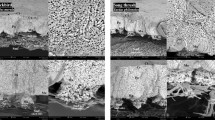Summary
The continuous “loculose” organic structure in “cones” and “caps” of the avian egg shell (the “mamillary cores” of the English literature), was thoroughly investigated in the Nandu (Rhea americana) as well as in the duck (Anas domestica) by means of etched cross-ground sections, impregnated with gold (see page 195). This procedure shows the loculi in grey-blue or violet-blue, the shell membrane fibres in brown or wine-red, and the caps in a mixed colour of both.
Each loculus envelops a single calcite crystal. The greatest thickness of the organic septa is found in the crystallization centre of the calospherites; therefore the impregnation is sometimes so strong, that they have an opaque appearance. The loculi of the cones vanish gradually towards the columnar layer. The radial differentiation and the concentric striation of the loculi in the cones as well as their behaviour in the primary spherites are described in detail. In the caps the loculi separate not only neighbouring crystals, they also limite the crystals towards the shell membrane fibres, which interlace the cap.
The loculi originate from the organic part of the shell-forming secretion, which remains there after the individual calcite crystals have fallen out; in a kind of “self-purification” process, the outgrowing crystals press the organic material into the gaps beetwen them, where its hardens.
Zusammenfassung
Das zusammenhängende organische Fachwerk in „Kegeln“ und „Kalotten“ der Vogel-Eischale — in der Literatur als „Mamillenkern“ beschrieben —, von uns als „Loculi“ bezeichnet, wurde insbesondere beim Nandu (Rhea americana), daneben auch bei der Hausente (Anas domestica) an angeätzten Schalenquerschliffen mittels Goldimprägnation (s. S. 195) dargestellt. Das Fachwerk erscheint dann in den Kegeln graublau bis blauviolett, die Schalenhautfasern werden dunkelbraun oder weinrot, und die Kalotten heben sich von der umgebenden Membran in einem dunklen Mittelton ab.
Jeder Loculus umhüllt in dem genannten Bereich das einzelne Calcitindividuum. Die organischen Septen des Kegelfachwerks sind im Bildungszentrum der Calcosphäriten am dicksten, weshalb dieses oft so stark imprägniert wird, daß es kaum mehr Licht durchläßt. Gegen die Säulenlage hin läuft das Kegelfachwerk allmählich aus. Die radiale Differenzierung und konzentrische Bänderung des Fachwerkes im Kegel, insbesondere sein Verhalten im Primärsphänten, werden des Näheren geschildert. In der Kalotte trennt das Fachwerk nicht nur benachbarte Calcitindividuen, sondern es grenzt diese auch gegen die Schalenhautfasern ab, welche die Kalotte durchziehen.
Die Loculi entstehen aus dem organischen Anteil des schalenbildenden Sekretes, der beim Ausfallen der Calcitindividuen zurückbleibt. Beim Auswachsen drängen die Kristalle das organische Material durch einen „Selbstreinigungsprozeß“ in die Lücken zwischen ihnen, wo es erhärtet.
Similar content being viewed by others
Literatur
Schmidt, W.J.: Die Primärsphäriten der Hühner-Eischale. Z. Zellforsch. 62, 48–52 (1964a).
—: Nochmals über die Primärspäriten der Hühner-Eischale. Z. Zellforsch. 63, 682–685 (1964b).
—: Bemerkungen zur leichten Löslichkeit der Calcosphäriten-Zentren in der Vogel-Eischale. Z. Zellforsch. 64, 726–732 (1964c).
—: Die organischen Kerne der Mammilen in den Frühstadien der Eischalenbildung bei der Lachmöwe. Z. Zellforsch. 65, 713–718 (1965a).
—: Goldfärbung der Schalenhautfaaern des Vogeleies am Schliff. Z. wiss. Mikr. 67, 51–54 (1965b).
—: Die Eisosphäriten (Basalkalotten) der Schwanen-Eischale. Z. Zellforsch. 67, 151–164 (1965c).
Terepka, A.R.: Structure and calcification in avian egg shell. Exp. Cell Res. 30, 171–182 (1963a).
—: Organic-inorganic interrelationship in avian egg shell. Exp. Cell Res. 30, 183–192 (1963b).
Tyler, C.: A study of the egg shells of the Anatidae. Proc. zool. Soc. Lond. 142, 547–583 (1964).
—, and K. Simkiss: Studies on egg shells. VIII. The determination of membrane-, pore- and matrix-protein—a reassessment. J. Sci. Food Agr. 6, 375–380 (1958).
—: Studies on egg shells. XII. Some changes in the shell during incubation. J. Sci. Food Agr. 11, 611–615 (1959).
Author information
Authors and Affiliations
Rights and permissions
About this article
Cite this article
Schmidt, W.J. Das organische Fachwerk in „Kegeln“ und „Kalotten“ der Vogel-Eischale. Zeitschrift für Zellforschung 68, 194–204 (1965). https://doi.org/10.1007/BF00342429
Received:
Issue Date:
DOI: https://doi.org/10.1007/BF00342429




